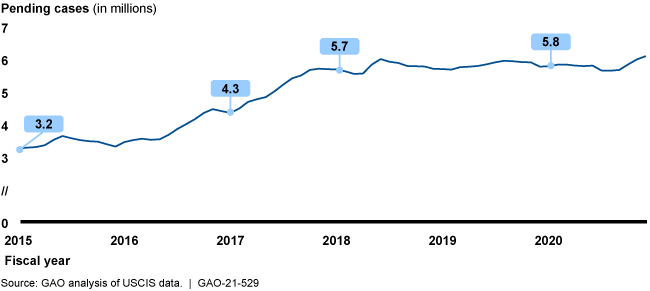GAO-21-529 Published: Aug 18, 2021. Publicly Released: Sep 17, 2021.
U.S. Citizenship and Immigration Services processes millions of applications and petitions from noncitizens who want to temporarily stay or live in the country, obtain work authorization, or become U.S. citizens.
We looked at USCIS's efforts to reduce its pending caseload, which has increased by 85% in recent years. Policy changes, longer forms, staffing issues, and delays from COVID-19 contributed to longer processing times. Although USCIS has several plans to address the backlog, it hasn't implemented them and hasn't identified necessary resources.
We recommended that USCIS identify necessary resources to address its pending caseload.
U.S. Citizenship and Immigration Services (USCIS) Estimated Total Pending Caseload, Fiscal Years 2015 through 2020

What GAO Found
Data from the Department of Homeland Security's (DHS) U.S. Citizenship and Immigration Services (USCIS) indicate the agency's total pending caseload-–the number of cases awaiting a benefit decision-–grew an estimated 85 percent from fiscal years 2015 through 2020. GAO's analysis shows that, while the number of applications and petitions for immigration benefits (forms), such as humanitarian relief and naturalization, received by USCIS remained between about 8 and 10 million each fiscal year from 2015 through 2019, USCIS's median processing times—the median length of time from the date USCIS received a form to the date it rendered a decision on it—increased for six of the seven forms that GAO selected for review. USCIS officials cited several factors that contributed to longer processing times, including policy changes resulting in increases in the length of USCIS forms and expanded interview requirements; insufficient staffing levels; and suspension of in-person services due to the COVID-19 pandemic.
U.S. Citizenship and Immigration Services (USCIS) Estimated Total Pending Caseload, Fiscal Years 2015 through 2020

USCIS monitors its operations using performance measures, including some measures related to its case processing timeliness. However, USCIS does not have these timeliness measures for four of the seven forms that GAO reviewed. Three of these four forms comprised about 41 percent of the agency's total pending caseload at the end of fiscal year 2020. Developing and implementing timeliness performance measures for certain forms, particularly those with significant pending caseloads, would provide USCIS leadership with a better understanding of areas that may require improvement.
USCIS conducts short-term workforce planning by using staffing models that estimate the volume of new forms USCIS will receive for the next 2 fiscal years and the number of staff needed to address them. USCIS has also implemented several strategic and operating plans that include workforce-related goals. However, it has not developed long-term strategies for acquiring, developing, and retaining staff. Developing a strategic workforce plan would better position USCIS to address long-term workforce challenges and reduce its growing pending caseload. USCIS has also developed four plans to reduce its pending caseload, but has not implemented or updated them to reflect funding and other resources needed to address the pending caseload. Identifying the resources necessary to address its pending caseload and providing the estimates to the Office of Management and Budget and Congress would better inform them about USCIS's resource needs.
Why GAO Did This Study
USCIS is the federal agency charged with adjudicating applications and petitions for immigration benefits, such as humanitarian relief, naturalization, and employment authorization.
GAO was asked to review issues related to USCIS's caseload. This report examines (1) what USCIS data indicate about its caseload, including its pending caseload, and factors affecting it; (2) how USCIS monitors its case processing operations, including efforts to reduce its pending caseload; and (3) the extent to which USCIS has implemented workforce planning strategies to address its pending caseload. GAO analyzed USCIS documentation and data for fiscal year 2015 through the second quarter of fiscal year 2020 and interviewed officials from USCIS program offices, directorates, and eight field locations and from three external stakeholder organizations. GAO also analyzed USCIS processing time data for seven types of applications and petitions, selected based on various factors, including volume of pending caseload and benefit category.
Recommendations
GAO is making six recommendations, including that USCIS develop performance measures for monitoring the timeliness of its case processing for certain forms, develop a long-term workforce plan, and identify the resources necessary to address its pending caseload. DHS concurred with five recommendations and did not concur with the recommendation that USCIS develop a long-term workforce plan. GAO continues to believe that such a plan would help USCIS better address its workforce challenges.
Recommendations for Executive Action
| Agency Affected | Recommendation | Status |
|---|---|---|
| United States Citizenship and Immigration Services | The Director of USCIS should develop and implement a plan with time frames for verifying and closing cases in CLAIMS-3 that are recorded inaccurately as pending. (Recommendation 1) |
Open <label class="status-code-label">Open</label><p class="status-code-description"><p>Actions to satisfy the intent of the recommendation have not been taken or are being planned, or actions that partially satisfy the intent of the recommendation have been taken.</p></p> When we confirm what actions the agency has taken in response to this recommendation, we will provide updated information. |
| United States Citizenship and Immigration Services | The Director of USCIS should develop and implement performance measures for monitoring and reporting the timeliness of processing applications and petitions that have significant pending caseloads. (Recommendation 2) |
Open <label class="status-code-label">Open</label><p class="status-code-description"><p>Actions to satisfy the intent of the recommendation have not been taken or are being planned, or actions that partially satisfy the intent of the recommendation have been taken.</p></p> When we confirm what actions the agency has taken in response to this recommendation, we will provide updated information. |
| United States Citizenship and Immigration Services | The Director of USCIS should develop performance measures for its process improvement projects to monitor the extent to which those projects reduce case processing times. (Recommendation 3) |
Open <label class="status-code-label">Open</label><p class="status-code-description"><p>Actions to satisfy the intent of the recommendation have not been taken or are being planned, or actions that partially satisfy the intent of the recommendation have been taken.</p></p> When we confirm what actions the agency has taken in response to this recommendation, we will provide updated information. |
| United States Citizenship and Immigration Services | The Director of USCIS should incorporate key risk factors, such as risks posed by hiring delays and attrition, into its staffing models. (Recommendation 4) |
Open <label class="status-code-label">Open</label><p class="status-code-description"><p>Actions to satisfy the intent of the recommendation have not been taken or are being planned, or actions that partially satisfy the intent of the recommendation have been taken.</p></p> When we confirm what actions the agency has taken in response to this recommendation, we will provide updated information. |
| United States Citizenship and Immigration Services | The Director of USCIS should develop a long-term workforce plan that includes strategies for acquiring, developing, and retaining staff. (Recommendation 5) |
Open <label class="status-code-label">Open</label><p class="status-code-description"><p>Actions to satisfy the intent of the recommendation have not been taken or are being planned, or actions that partially satisfy the intent of the recommendation have been taken.</p></p> When we confirm what actions the agency has taken in response to this recommendation, we will provide updated information. |
| United States Citizenship and Immigration Services | The Director of USCIS should identify the resources necessary to address its case backlog and inform key stakeholders, such as the Office of Management and Budget and Congress. (Recommendation 6) |
Open <label class="status-code-label">Open</label><p class="status-code-description"><p>Actions to satisfy the intent of the recommendation have not been taken or are being planned, or actions that partially satisfy the intent of the recommendation have been taken.</p></p> When we confirm what actions the agency has taken in response to this recommendation, we will provide updated information. |
Full Report
Case managementImmigration benefitsImmigration servicesPerformance measurementProject managementStaffing levelsWorkforce planningCitizenshipHuman capital managementPolitical asylum
U.S. Citizenship and Immigration Services: Actions Needed to Address Pending Caseload - Government Accountability Office
Read More

No comments:
Post a Comment